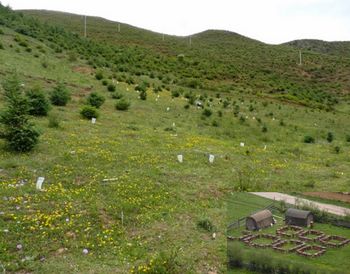Scientists Revealed Pollinator Abundance Shifted the Plant–plant Interactions
2013-11-08
Pollinator abundance is an important environmental factor influencing plant reproductive success, however, few experimental studies directly investigate whether and how pollinator abundance affects plant–plant pollination interactions.
Under the supervision of Prof. WANG Qingfeng, Dr. YE Zhongming from Wuhan Botanical Garden artificially created two levels of pollinator abundance and investigated the effects of conspecific and interspecific flower densities on pollination of a focal plant in a two- year experiment. Lotus corniculatus L. (Fabaceae), Birdsfoot trefoil, a common herb in meadows of Southwestern China was used as the focal plant; while the coflowering plant wasPotentillareptans var. sericophylla (Rosaceae).
Pollinator abundance as well as flower density significantly affected pollination of L. corniculatus from both the conspecific and interspecific plots. Total number of bees visiting a plot was enhanced by an increase in both the conspecific and interspecific flower densities regardless of high or low pollinator abundance. However, changes in visitation rates and fruit sets of L. corniculatus only when flower densities were increased depended on pollinator abundance.
Under high pollinator abundance, an increase in both the conspecific and interspecific flower densities significantly enhanced pollinator visits to L. corniculatus. However, under low pollinator abundance, the pollinator visitation rate remained unchanged as conspecific flower density increased, but decreased when there was an increase in interspecific flower density. Coflowering plants enhanced fruit sets of L. corniculatus only when the pollinator abundance was high.
The findings suggest that the interactions among plants for pollination are influencednot only by a plant density threshold, but also by a pollinator abundance threshold.
The research was supported by the National Natural Science Foundation of China and Strategic Pilot Science and Technology Projects of CAS. Relevant results were published in Plant Ecology entitled “Competition and facilitation among plants for pollination: can pollinator abundance shift the plant–plant interactions?”

To set up different levels of pollinator abundance, they employed a beekeeper to take beehives of A. melliferato, which were placed 100m away from the study site, providing supplementary pollination service in 2011. In 2012, beehives were restricted to 5km away from the study site. Two images are grouped together showed as follow. (Image by Dr. YE Zhongming)